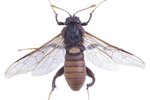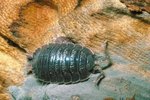
If you’ve ever batted swarms of tiny insects from your head at dusk, you’ve probably encountered a midge. These bugs might be small, but they can be extremely annoying. Although some types of midges are nothing more than a nuisance, other types feed on human blood and cause painful welts on the skin when they bite you.
Bugs, Bugs Everywhere
Non-biting midges, commonly called gnats, belong to the Chironomidae insect family. The green or brown bugs are about 1/8 inch in length and look like small mosquitoes. Like many insects, non-biting midges are drawn to bright lights. You might find swarms of them resting on screens or flying around your porch or outdoor lights. Non-biting midges enter buildings through small openings and can fly through screens and air-conditioning units. Although they die quickly, they can be quite a nuisance if you must deal with them indoors.
That Stings
Biting midges belong to the Ceratopogonidae family. They are commonly called “no-see-ums” because you might feel a sharp stinging sensation on your skin when you’re bitten, but might never see a bug. Biting midges also are about 1/8 inch in length and have gray bodies and wings. Nectar is the primary food source for biting midges of either sex, but midge eggs won’t mature unless the female obtains blood from other insects, animals or people, depending on the species of the biting midge. As the female feeds, blood accumulates in her abdomen. If you’ve ever swatted a midge, you might notice a small bloody spot, which is an indication the bug has recently fed.
Wet is Best
Biting and non-biting midges need water to live and reproduce, although the water source can be as small as a pail of forgotten water under your deck. Both types of midges are found throughout the world. If there’s a water source, midges can survive. Water sources can include puddles, streams, marshes, swamps, ponds, lakes and rivers. Moisture is the key to midge survival and their life cycle. The Animal Diversity Web notes that damp soil and even feces provide enough moisture for midges’ needs.
Breeding Requires Moisture
Midges couldn't successfully reproduce without moist or wet areas because eggs and larvae won't develop if they aren't kept moist. Females look for wet places to lay their eggs and, depending on the species, prefer bodies of water, aquatic plants, slimy logs or other moist surfaces. When the eggs hatch, larvae emerge and begin feeding on aquatic plants or debris. The amount of time the midges remain in the larval stage depends on the geographic area, species and temperature, but the stage can last between two weeks to one year, notes the University of Florida Entomology and Nematology Department. During the last stage of development, the larvae form cocoons and develop into mature insects.
References
Photo Credits
-
Jupiterimages/Stockbyte/Getty Images
Writer Bio
Working at a humane society allowed Jill Leviticus to combine her business management experience with her love of animals. Leviticus has a journalism degree from Lock Haven University, has written for Nonprofit Management Report, Volunteer Management Report and Healthy Pet, and has worked in the healthcare field.




